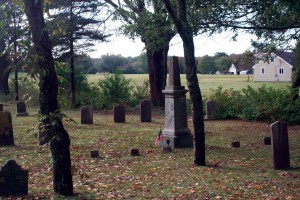The gravediggers worked hard digging through the cold February ground. The corpse had been buried for seven days during the dead of winter of 1841. Hopefully, the smell would not be as bad.
Rumors had begun to circulate in the days after the death of Thomas Randall. His death had come “by unfair means,” it was said. Unfair, presumably meaning he was murdered.
He was 43 years old and was eating dinner with his family when he fell back in his chair, began gasping for air and turned black in the face. He was known as an “intemperate man” and may have been drinking at the time. Before anyone could help him, if help was even attempted, he died.
It had snowed about six inches on February 1, the day after his death. The Reverend Thomas Robbins noted he attended a funeral the next day of the “drinking man who had died suddenly.” He was buried at the “Mattapoisett Cemetery” after the funeral.
Thomas Randall married Maribah Parlow on June 18, 1820 in Rochester. They had five children between 1821 and 1832, all girls. Perhaps it was because Mr. Randall was known as being a drunk and he had died suddenly with his family watching, people began to think his death was not an accident.
The rumors persisted and soon several people demanded an investigation. The coroner asked a jury to order a disinterment of the body, and on February 9, several men went to the cemetery with shovels in hand to dig up the remains of Thomas Randall. The news had spread throughout New England. Newspapers in New Bedford, Boston, Salem, Northampton and Keene, New Hampshire would report on the grizzly post mortem exam. Digging up bodies was not a common thing in 19th century. Social beliefs of the time thought of the dead body of something to be protected. There were also many superstitions about corpses, such as the belief that the living needed to be protected from the dead.
When the grave diggers made their way though the cold, icy ground and the several inches of snow that continued to fall during the past few days, they lifted the wooden coffin up and loaded it on to a wagon. The rotting corpse was carried through the streets of Mattapoisett to perhaps the office of one of the physicians in the village.
Waiting to observe the dissection and exam of the corpse was the coroner, the jury and “several spectators.” Dr. A. S. Jones of Mattapoisett was assigned to perform the post mortem exam. This same Dr. Jones would be charged a few years later along with another local doctor and a medical student for robbing a grave of a corpse for the purpose of dissecting it.
Dr. Jones went to work on the body of Mr. Randall while the onlookers observed in curious silence. Medical training at the time did not often include hands-on dissections of bodies. What one knew of anatomy was often learned through reading books and later while operating on living persons. Perhaps Dr. Jones took this opportunity to explore anatomy while performing the exam. Or perhaps he worked quickly because the corpse was already over a week old.
While examining the air passage of the deceased, Dr. Jones was sure he discovered the cause of death. Either by reaching in the mouth or cutting open the throat, Dr. Jones produced what appeared to be a mass of flesh. Upon further examination and knowledge of the menu of his dinner the night of his death, it was discovered that the mass lodged in the deceased’s throat was a large piece of boiled pork weighing about an ounce and a half.
The jury rendered a verdict of an accidental choking while eating. Any thoughts of an “unfair” death were quickly put to rest in Mattapoisett. Mr. Randall was returned to his grave where he has been, hopefully, at rest for the past 177 years.
By Kyle DiCicco-Carey
